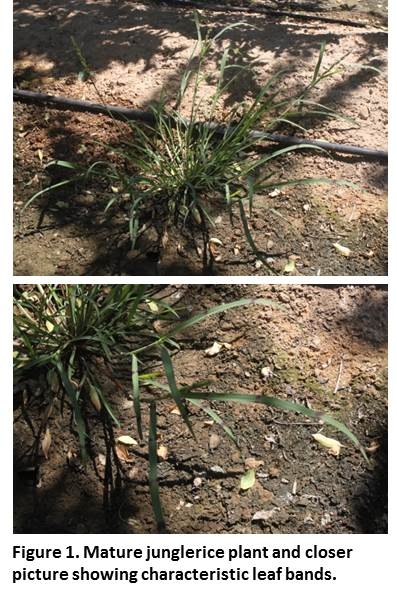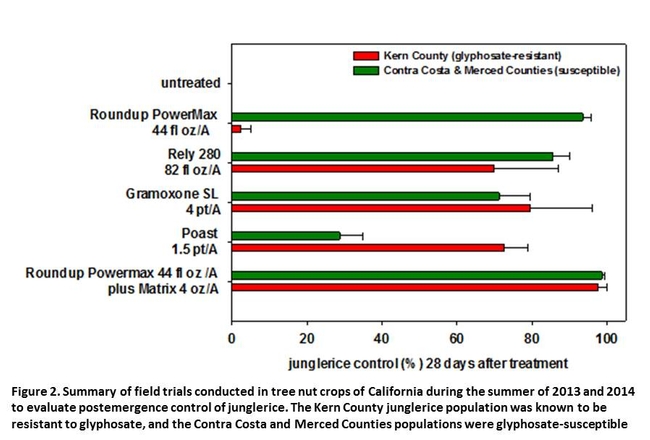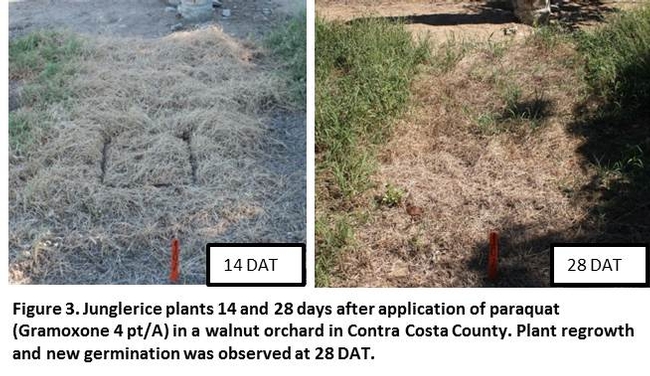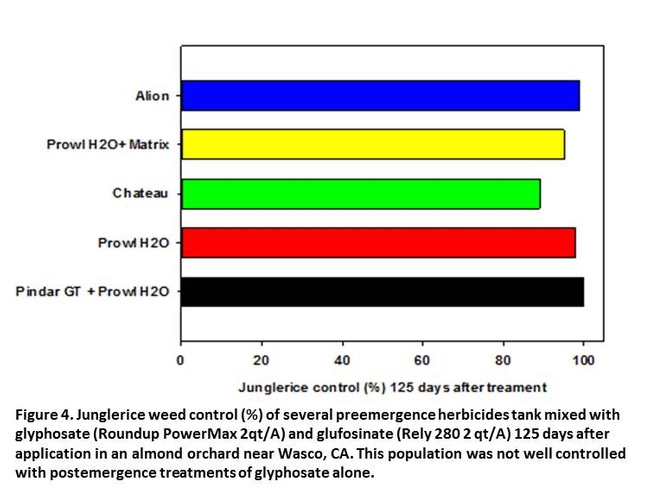This article was originally prepared for the CWSS Research Update and News (September 2014 edition). You can see it and several other articles at the CWSS website. You can also get information on the annual California Weed Science Society Conference which will be held in Santa Barbara January 21-25, 2015.
Brad
Managing Junglerice in Tree Nut Crops – a summer weed resistant to glyphosate
Marcelo L. Moretti1, Seth Watkins1, Bill Gary2, and Brad Hanson1
1University of California – Davis, CA; 2Mid Valley Ag – Linden, CA
Junglerice, or Echinocloa colona, is a summer grass commonly found in orchards, annual crops, and roadsides of California. This weed germinates in early spring and throughout the summer and can grow and reproduce quickly. Junglerice commonly is identified by purple bands on the leaves. However, in some populations or environmental conditions these stripes are less visible; thus a lack of banding should not be used as a definitive means of identification. In recent years, the feature that makes this summer grass really stand out in California fields is the discovery of glyphosate-resistant populations.
Glyphosate-resistant junglerice was first detected in the northern Central Valley in 2010. A subsequent survey in 2011 found glyphosate-resistant populations in Butte, Madera, and Kern Counties. At that time, glyphosate resistance was not found between Butte and Madera Counties. This erratic distribution of resistance suggested that these populations may have evolved resistance independently. This hypothesis was further supported by the work of Dr. Alarcon-Reverte and collaborators from UC Davis, who documented several different mechanisms of resistance in junglerice populations from California.
These findings have important implications for weed management. First, seed production and dispersal must be stopped to avoid spread of the populations that are already resistant to glyphosate. Even more important is that weed management programs should consider the adoption of strategies to mitigate selection of new glyphosate-resistant populations. Readers interested in more general information about the biology and management of herbicide resistant weeds should refer back to the January 2013 CWSS Research and Update News vol. 9 n. 1 (http://www.cwss.org/uploaded/media_pdf/4749-2013_01_CWSSResearch.pdf). In this article, the discussion will focus on herbicidal management of glyphosate-resistant junglerice in tree and vine crops.
Rotating or combining herbicide modes of actions is one of the first recommended practices to manage herbicide resistance. However, this practice is only effective when the alternate mode of action herbicide also has efficacy on the resistant species. Experiments were conducted during summer of 2013 and 2014 in tree nut crops of the Central Valley to compare postemergence control of junglerice with registered herbicides. Locations included Kern, Contra Costa, and Merced Counties. The Kern County location was known to be infested with glyphosate-resistant junglerice, but the susceptibility of the populations at the other two locations was not known.
The results indicated that glyphosate (RoundUp Powermax) was highly effective in controlling junglerice at the Contra Costa and Merced County locations; however, no control was observed with glyphosate in Kern County (figure 2). Concurrent greenhouse experiments indicated that the Kern population was 4-fold more tolerant of glyphosate than the reference susceptible population (data not shown). The other postemergence herbicides tested, glufosinate (Rely 280), paraquat (Gramoxone SL), or sethoxydim (Poast), all provided good initial control of junglerice; this indicates that there is no cross-resistance to these modes of action. However, because these herbicides have only postemergence activity, junglerice control declined by 28 days after application due to regrowth and emergence of new seedlings (figure 3). The combination treatment of glyphosate plus rimsulfuron in these studies provided good postemergence control of glyphosate-susceptible and –resistant junglerice as well as residual control for several weeks.
Complete control of junglerice with postemergence herbicide programs can be a challenge in orchards. Summer grasses like junglerice can germinate throughout the growing season as long as soil moisture and temperature conditions are favorable; thus repeated applications of postemergence treatments will likely be needed. Additionally, junglerice plants grow rapidly and can become too big for effective control with some herbicides. Survivors and new plants can produce seed before tree nut harvest operations and further increase the infestation in the orchard. Therefore, postemergence-only herbicide programs are not likely to provide consistent and economical control of junglerice in orchard but should instead be used as part of a management program that includes preemergence herbicides applied during the winter season.
Preemergence herbicides are an important tool to be included in the weed control of junglerice and other weeds in tree and vine crops. From a resistance management standpoint, most of the preemergence herbicides have different modes of action than the available postemergence herbicides. In addition to aiding rotation of herbicide modes-of-action, the preemergence herbicides provide extended control of multiple flushes of germinating junglerice during spring and part of the summer. For example, excellent control of junglerice was observed for more than 125 days with several preemergence herbicide treatments (figure 4).A list of preemergence herbicides registered in tree & vine crops of California is available at the Weed Research and Information Center (WRIC) website (http://wric.ucdavis.edu).
Several preemergence and postemergence herbicides provided effective control of glyphosate-resistant junglerice in tree nut crops. This suggests that there is no cross-resistance to these important management tools. Growers can use these herbicides with different modes of action in an integrated approach to reduce the selection pressure for glyphosate-resistant junglerice.
In addition to the herbicide research described here, UC Davis, UCCE, CSU Fresno researchers as well as members of the private sector are also addressing aspects of biology, ecology, and genetics of glyphosate resistance. These collaborative efforts should lead to integrated weed management strategies for junglerice and other problematic weeds in tree and vine crops.

